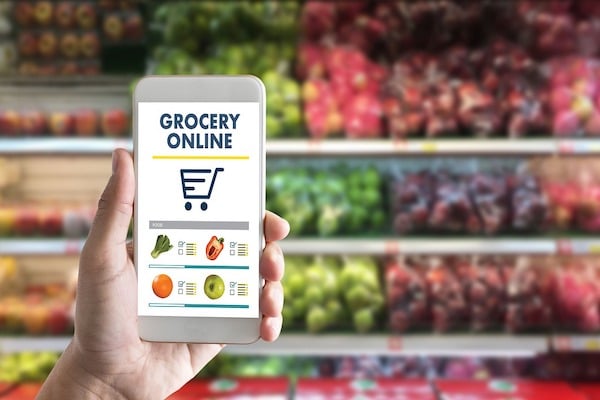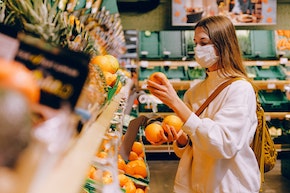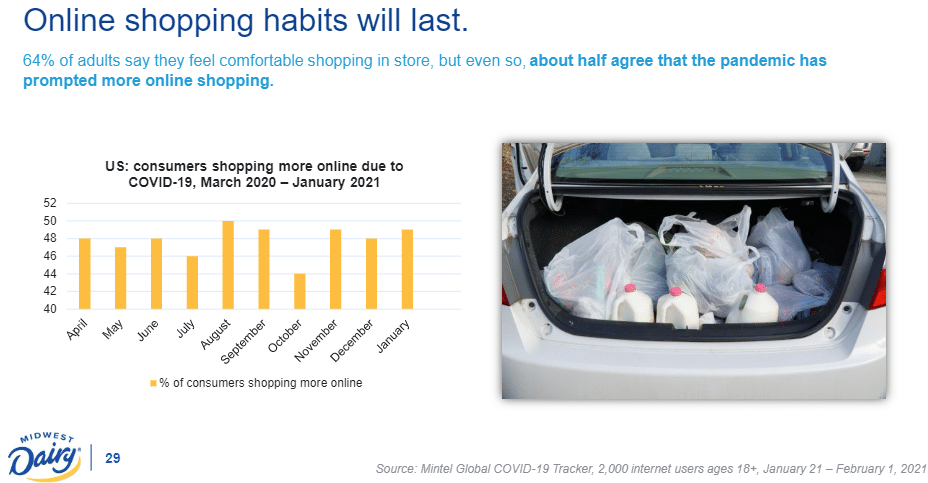
According to an UBS analyst, overall grocery sale grew 11% last year but are projected to drop 5% in the coming year as vaccinated customers return to restaurants and reliance on supermarkets as the sole source of food declines.2 Leah McGrath, RD, LDN, a corporate dietitian with Ingles Markets concurred: “Yes, I suspect that many retailers will start seeing a move back towards some pre-pandemic numbers and practices, especially when it comes to on-line purchasing and types of products purchased. (I think the days of banana and sourdough bread baking may be over for most!)”
What’s In Our Baskets
As mentioned, during the early days of the pandemic, flour became difficult to find as I can personally attest. For one that traditionally bakes, last spring was one of the few times I couldn’t find flour of any type on my local shelves, but as the supply adjusted to demand, flour returned to its place. In addition, center-of-the-aisle purchases of canned food products increased as consumers stockpiled and unfounded concerns about virus transmittal on fresh produce spread. Frozen food sales in 2020 grew by more than 21% with nearly all categories seeing double-digit sales increases.

From Footprint to Fingertip
Online shopping had been gaining momentum over the years, but the pandemic accelerated the growth. According to industry experts, the growth or transition to digital probably was escalated by three years or so.3 For example, Kroger experienced a 116% growth in digital sales in 2020.1 From trend data to personal insights, I can attest that online shopping is here to stay.
According to Mintel trends shared in a recent Midwest Dairy webinar, 64% of consumers state they feel safe shopping in person but 50% agreed the pandemic had prompted more online shopping. McGrath says she definitely saw the growth in on-line, curbside and home delivery and expects the convenience of these services will not be abandoned completely by customers. She anticipates a “hybrid model” adoption by some where the majority of staples are ordered on line supplemented by in store visits for perishable items. McGrath’s description reflects the shopping “norms” for a couple of my Boomer age friends. Having never shopped online prior to COVID, both stated they would retain their new found habit of splitting shopping between online and in-person with 25-50% done in person for fresh produce, a quick pick up or just to stay informed about new products. But online shopping will continue to play a dominant role. As one friend stated, “I plan better, save money and those impulse buying urges are eliminated” when I shop online.
Planning for the Future

If the hybrid shopping model continues, the brick-and-mortar grocery store of the future may resemble the smaller model described above. In fact, The Hartman Group, a consumer trends research group, predicated several years ago that the size of supermarkets would decrease as online shopping gained popularly. Little did we know that a pandemic would move our future closer to that reality.
Forever Essential and Grateful
Regardless of store size or organization, gratitude and appreciation go to all personnel along the food value chain this past year. From the grower and processor to the delivery personnel and the in-store employees selecting groceries for online customers or keeping shelves stocked, their commitment kept the “center of our universe” normal … a welcomed relief in a sea of uncertainty.
References:
1. “Kroger ups average pay to $15.50 per hour as digital sales top $10 billion,” by Alexander Coolidge of the Cincinnati Enquirer, USA Today, March 4, 2021.
2. “Grocery stores’ pandemic boom is over,” by Nathaniel Meyersohn, CNN Business, March 5, 2021.
3. “Is there a secret sauce to Kroger’s online success?” by Al McClain, Retail Wire, December 17, 2020.
4. “How Hy-Vee Plans to Grow,” by Bridget Goldschmidt, Progressive Grocer, March 9, 2021.
5. “Aldi to open 100 new stores and expand curbside pickup in the US,” By Ronnie Koenig, Today.com, February 10, 2021.

